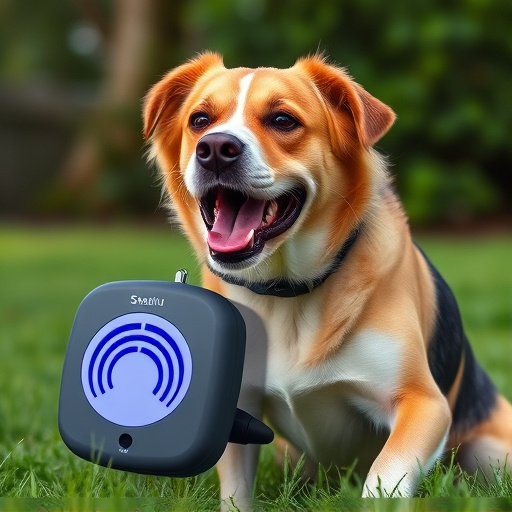When choosing portable dog training equipment, opt for FDA-approved dog repellent devices that use ultrasonic sound waves to deter unwanted behaviors like barking or jumping, offering a safe and effective alternative to traditional methods. These devices emit inaudible high-frequency sounds that are uncomfortable for dogs but harmless to humans and other animals, making them ideal for modifying canine behavior both at home and during travel. Regular monitoring and proper usage ensure optimal results while prioritizing animal comfort.
“Unleash a well-behaved canine companion with the power of portable dog training ultrasonic equipment. This innovative technology offers a non-invasive approach to behavior modification, backed by scientific research and approved by the FDA. Our article delves into the inner workings of these devices, exploring their effectiveness in training while ensuring safety. We’ll guide you through understanding the legal aspects as FDA Approved Dog Repellent Devices, providing insights on benefits, precautions, and tips for selecting the perfect portable ultrasonic trainer to transform your dog’s behavior.”
- Understanding FDA Approved Dog Repellent Devices
- How Portable Ultrasonic Equipment Works for Dog Training
- Benefits and Safety Precautions of Using These Devices
- Choosing the Right Portable Dog Training Ultrasonic Equipment
Understanding FDA Approved Dog Repellent Devices
When considering portable dog training ultrasonic equipment, it’s crucial to understand the importance of FDA-approved dog repellent devices. These products are specifically designed and tested to be safe for both pets and users, ensuring they meet stringent regulatory standards. The U.S. Food and Drug Administration (FDA) evaluates these devices based on their effectiveness in deterring unwanted behaviors while also assessing potential risks to animal health and well-being.
FDA-approved dog repellent devices often utilize ultrasonic sounds or other non-harmful methods to discourage dogs from specific areas or behaviors. Unlike traditional repellents that may rely on strong chemicals, these products offer a humane alternative. By understanding the FDA’s approval process for dog repellent devices, pet owners can make informed decisions, ensuring they invest in safe and effective tools for their canine companions’ training and behavior modification.
How Portable Ultrasonic Equipment Works for Dog Training
Portable ultrasonic equipment has emerged as a popular and effective tool for dog training, particularly when it comes to addressing unwanted behaviors like barking or jumping. These devices emit high-frequency sound waves that are inaudible to humans but can be sensed by dogs, making them an excellent alternative to traditional, often harsher methods. The ultrasonic waves work by stimulating the dog’s hearing without causing physical harm, which sets them apart from other dog repellent devices and makes them FDA-approved.
When activated, these portable trainers emit a consistent high-pitched sound that is unpleasant for dogs but virtually imperceptible to humans. This sound serves as an immediate behavioral modifier, encouraging dogs to stop the behavior that triggered it. Over time, the association between the unwanted action and the ultrasonic tone leads to a reduction in such behaviors. The portability of these devices makes them convenient for outdoor training sessions or even travel, allowing pet owners to continue training their dogs in various environments.
Benefits and Safety Precautions of Using These Devices
Portable dog training ultrasonic equipment offers a non-violent and effective approach to modifying canine behavior, making them invaluable tools for pet owners and professional trainers alike. These devices emit high-frequency sound waves that are unpleasant to dogs but harmless to humans and other animals. The primary benefit lies in their ability to deter unwanted actions like barking, jumping, or chewing without causing physical harm or pain. This makes them an excellent alternative to traditional, potentially harmful repellents or punishment methods.
While these FDA-approved dog repellent devices are generally safe, it’s crucial to observe certain precautions. Not all dogs react in the same way; some may be more sensitive to ultrasonic frequencies. Therefore, proper placement and use are essential. Keep the device out of reach of young children and ensure pets do not have direct contact with it. Regular monitoring during use is advised to prevent any adverse reactions and to adjust settings as needed for optimal effectiveness and comfort.
Choosing the Right Portable Dog Training Ultrasonic Equipment
When selecting a portable dog training ultrasonic equipment, it’s crucial to consider factors that ensure safety and effectiveness. Opt for FDA-approved dog repellent devices designed specifically for canine behavior modification. These devices emit high-frequency sound waves that are harmless to dogs but can capture their attention and deter unwanted behaviors like barking or jumping.
Choosing the right equipment means understanding your dog’s triggers and needs. Different models offer varying frequency ranges, power levels, and design features. A well-made, durable device with adjustable settings will provide more versatility in training different breeds and behavior issues. Always prioritize products that are easy to use, compact for portability, and feature safety mechanisms to prevent accidental activation by children or other pets.
Portable ultrasonic dog training equipment offers a safe and effective way to teach canine behavior, leveraging FDA-approved technology that emits high-frequency sound waves. By understanding how these devices work, their numerous benefits, and crucial safety precautions, pet owners can make an informed decision when choosing the right product for their furry companions. Incorporating this innovative approach into dog training routines can lead to positive results for both pets and their handlers.
